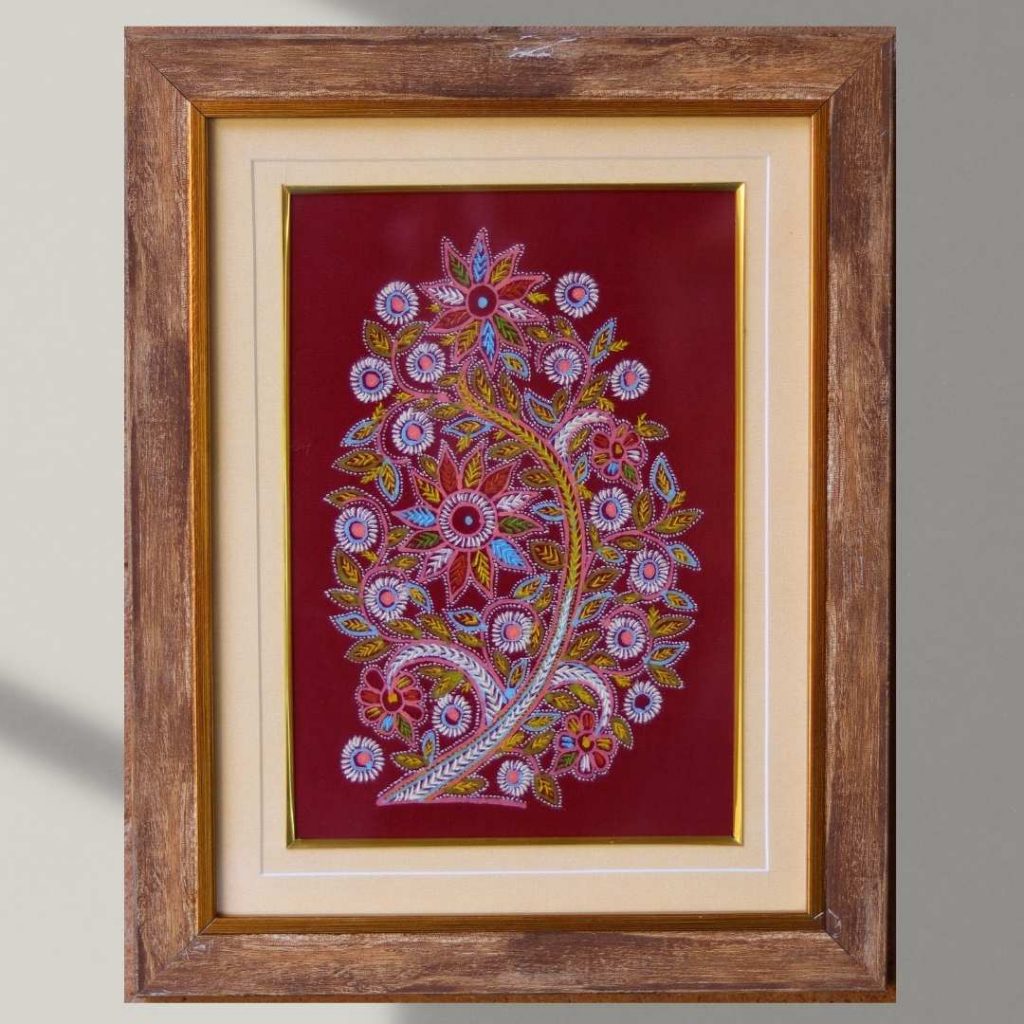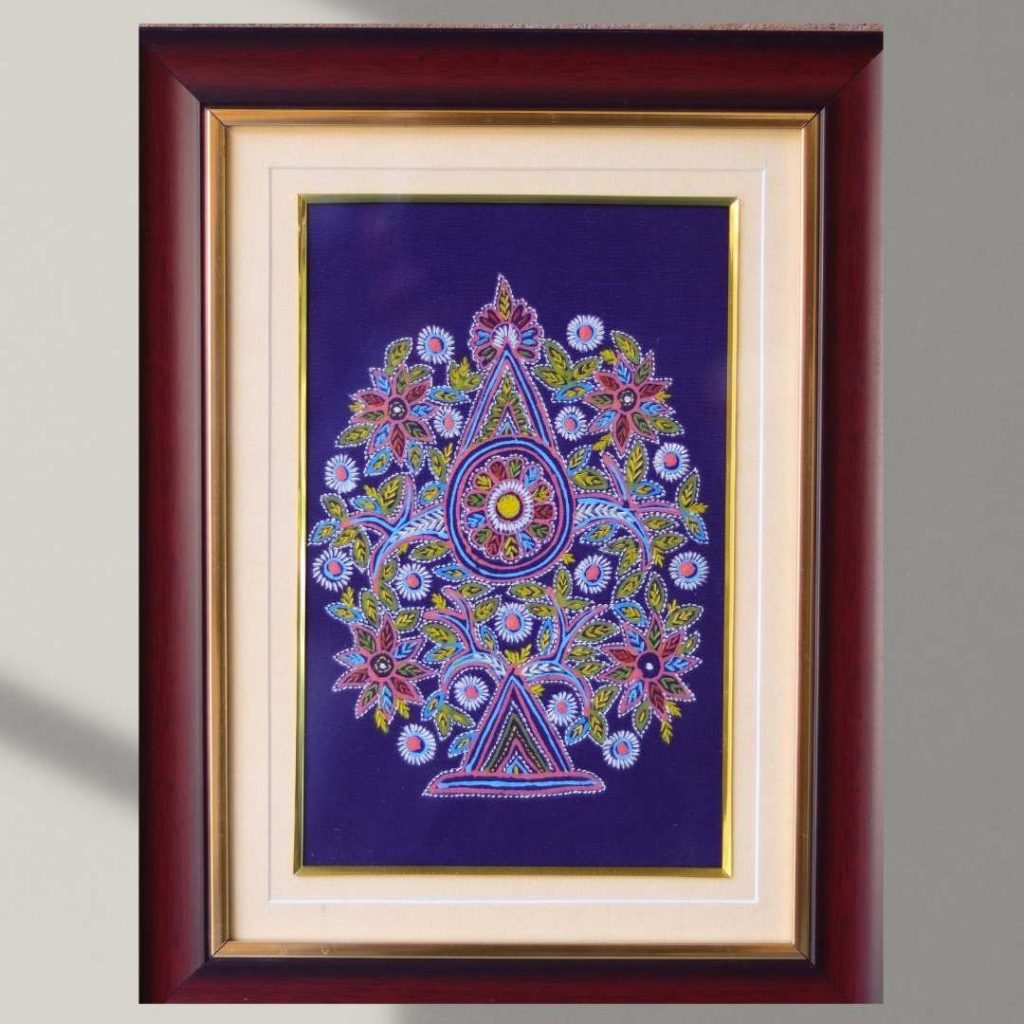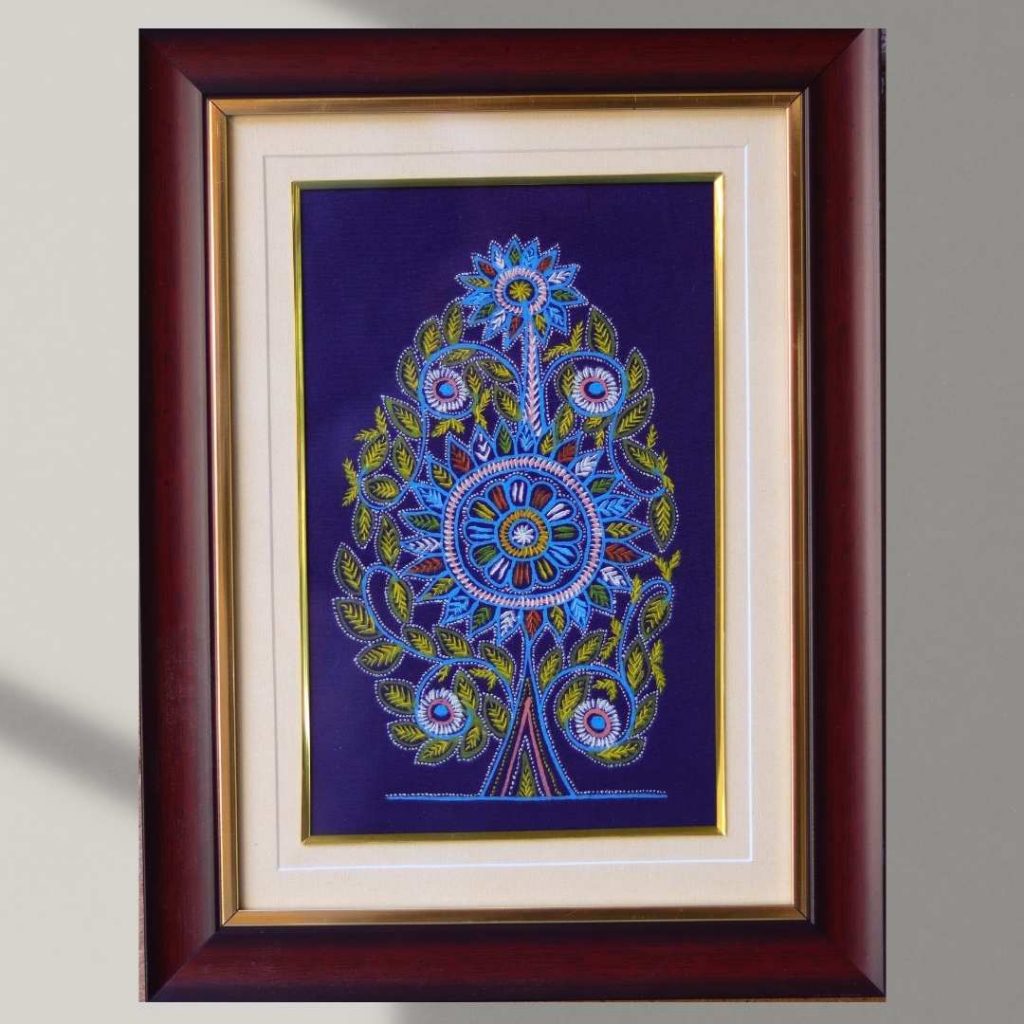Mohmad Hanif Arab Khatri comfortably seats himself on the floor. Stretched out before him is a piece of blue cloth, pinned on either side to the legs of a low-length table. Reaching for his dibbi, he pulls out a stylus and a blob of a thick brownish gelatinous substance. The tacky-looking gel wafts a faintly resinous odour into the room, pleasant and oddly familiar. It is reduced from castor oil, Hanif tells us.
“We boil castor oil for two or three days. It has to be watched carefully to make sure that it does not catch fire,” he tells. Too much heat would make it catch flame and with too little of it, the castor oil won’t be reduced to the right consistency. Natural coloured powders (ground-down minerals) in yellow, green, white, orange, blue, pink and black are mixed with this paste over a grinding stone until a uniform consistency is achieved. These coloured pastes are then stored in small containers or dibbis filled with water to ensure that they remain moist.
With the help of a kalam or metal stylus, he begins twisting a thick spool of already prepared yellow paint around the stylus. He dabs it a couple of times on the heel of his left palm. “It’s a gummy mass that has to be worked into something more malleable“, Hanif tells.
Using the tip of his kalam, he creates an elastic strand of colour and begins applying fluid strokes like a Mehndi artist. There are no tracings or pre-drawn lines; only continuous freehand work dictated entirely by his imagination. He doesn’t falter one bit and goes on, unaffected by the din around. Before we know it, the fabric is ready — yellow intricate floral patterns against the dark blue cloth.
He then folds the cloth and, just like that, a flawless mirror-image of the pattern appears. “Yeh hota hai Rogan kaam,” he gives us a satisfied smile. While we still try to catch our breaths, stunned by the brilliance of his work, he quickly draws out an old rusty peti from behind him. Emptying its contents, he begins showing us fabric after fabric, all covered in Rogan kaam from edge to edge.
“Not all can draw using a needle-like stylus,” Hanif says. It requires a steady hand, tremendous skill and a lot of practice as there’s no pre-sketched pattern. It is a freehand painting style. “Every piece is unique because each line, each pattern has been hand-crafted. No two designs can ever be the same,” he adds. Besides, the artwork is also slow and painstaking, depending on the type of fabric and the complexity of the work. “It takes anywhere from a few days to sometimes even a year,” he tells. A 14×17-inch painting would take him around 12 days to complete.
We were looking at an art-form that had its origin in Persia and travelled to India over 400 years ago. As if he could read our minds, Hanif begins to tell us how this ancestral art had nearly died out. “Pehle ke zamane mein hum bade paimane par maldhariyo aur kisano ke kapde ranga karte the. Phir machine se bane hue kapde aane lage, ek kifayti vikalp, aur dheere-dheere Rogan ne apna aakarshan khona shuroo kar diya” he explains. Their handmade pieces could not compete with machine-made ones, which forced many artists to abandon their art. What’s worse is that they began working as labourers.
Back then, Khatri families across villages of Nirona, Khavda and Chaubari in Kutch, Gujarat used to practice Rogan kaam. Today, there remain just two family units, based in Nirona and Anjar, that are sustaining this craft. According to Hanif, these are the only people in the whole world who have preserved and developed the intricate art of Rogan.
“Our family revived this dying craft in 1985,” he tells. The family head, Abdul Gafur Khatri, a 2019 Padma Shri recipient, managed to salvage some vestiges of Rogan art’s former glory. Today all 10 male members of the Gafur bhai Khatri household practice this craft — some even have State and National awards to their names.
In order to give this heritage craft a meaningful place in today’s times, they produce items such as wall-hangings, pillow covers, table-cloths with imagery that combines influences of Persian miniatures and local folk art. These are designed mainly for the international market. The main theme revolves around the “Tree of Life”. Besides, in an attempt to increase the outreach of the craft, the family has trained 60 local girls from other communities.
Yet, below the surface, things aren’t as positive as they seem. Courtesy, the ongoing global pandemic. Around March to December is usually when business picks up for the Khatris. Their home would bustle with visitors, mostly tourists, Indians and Foreigners. The sales would then see a high. But because of the pandemic, all their demonstrations have either been cancelled or put on hold, and they haven’t received any new orders.
“If not for live demonstrations, where you are shown the process and are allowed to touch and feel the designs, as well as to confirm for yourself that they do have raised textures, Rogan art can be mistaken for embroidery or print work,”
Hanif while explaining the reasons behind their demonstrations to help people appreciate and value their products.
Due to Rogan’s high dependency on tourism, they haven’t received any new group bookings. This is a concern for the artisans as it makes the future of their craft uncertain. They might not see visitors even in the next season. Despite their suddenly blank schedules and an interruption to seasonal sale patterns, Hanif tells that not all hope is lost. They were once able to breathe a second life into Rogan. This time too, they will draw on their rich-but-checkered past, to work their way through the crisis.
“We have been using this time as an opportunity to reinvent some of our previous works and designs, and are trying to create new innovations within our craft,” he shares. Survival and resilience are built into their systems of production and living, for the experience of the 2001 earthquake has taught them enough about staying prepared for hard times.
You could check out some of the family’s Rogan artworks here.










0 Comments